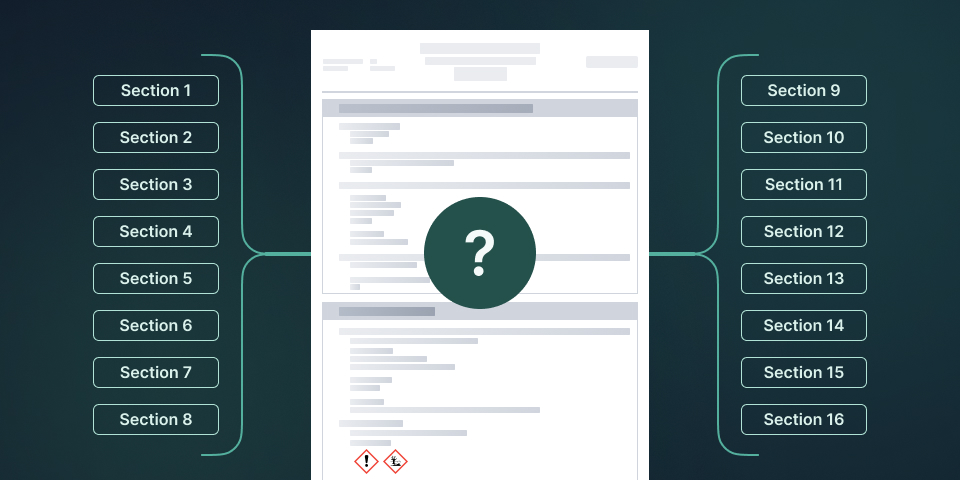In recent times, PFAS have become one of the most talked-about topics in the chemical compliance sphere. Due to their unique chemistry and properties, often called ‘forever chemicals,’ these substances have been used in a wide range of industries and can be found across a wide range of products, materials, and industries — both intentionally added and as trace contaminants. Regulators worldwide are now racing to restrict, report, and ultimately phase out their use.
In this article we will provide an overview of what PFAS are, why they matter, the current and upcoming legal obligations, and what companies can do today to stay compliant and prepare for the future.
What is PFAS?
What are PFAS substances?
PFAS stands for Per and poly fluorinated alkyl substances. They are a group of persistent organic substances that all consist of a carbon chain in which hydrogen atoms are entirely or partly replaced by fluorine atoms.
One thing that they all have in common is that they are very stable chemicals and that they are all man made. They can’t be found in the environment naturally occurring. That chemical stability is what gives them useful properties as they are known for their water, oil, and heat resistance. These same properties that make PFAS useful in products like non-stick cookware and waterproof clothing also make them highly persistent in the environment and human body.
The definition of PFAS
The definition has evolved significantly over time across different regulatory bodies and international frameworks, reflecting growing scientific understanding and regulatory needs.
Early definitions were loosely referred to as perfluorinated chemicals, fluorinated organics, or highly fluorinated compounds. Focus was mainly on PFOA and PFOS, as the most studied PFAS compounds.
Today, most regulatory bodies and regulations follow, use or refer to OECD definition from 2021:
This definition is structure-based, broad, and intended for regulatory and inventory purposes. According to some sources it captures ~24 million structures in chemical databases.
Still, for majority of regulations, PFAS are a very large family of synthetic fluorinated chemicals – covering well over 10,000 substances— including well-known members such as PFOA, PFOS, PFHxS and GenX.
Why are PFAS a problem?
PFAS have a wide range of applications and today can be found almost everywhere in the environment and are present in the bodies of almost every human being. According to some statistics, in Europe, more than 20 million people have been exposed to drinking water with PFAS levels above the safe limits. They are also known as “forever chemicals”, a term which you can mostly hear used by media, because they never break down and remain present in the human body.
These substances are extremely persistent and accumulate in soil, water, and living organisms. Certain substances have been linked to serious health effects such as cancer, liver and thyroid disease, and developmental issues. Their widespread contamination has led to massive remediation costs and growing liability risks.

Regulations and Restrictions
PFAS are currently getting under heavy regulatory scrutiny worldwide. In the EU, several PFAS (like PFOA, PFOS, and PFHxS) are already banned under REACH and the POPs Regulation. A comprehensive restriction proposal covering thousands of substances is currently under evaluation by ECHA.
In the US, the EPA has set national drinking water limits for several PFAS and classified PFOA and PFOS as hazardous substances under CERCLA, triggering clean-up and reporting obligations. Globally, the Stockholm Convention continues to add substances to its list of Persistent Organic Pollutants.
Below is the list of the main regional regulations that companies should monitor, and where relevant comply with:
International / treaty level
Stockholm Convention (POPs): Several subgroups are already listed as persistent organic pollutants (POP). PFOA (and related substances) and PFHxS (and related substances) are listed, and the Convention has considered additional substances (long-chain PFCAs) for listing. Listing typically triggers elimination/phase-out obligations for Parties.
European Union
Existing measures: Some PFAS (e.g., PFOA and certain long-chain PFCAs) are already restricted under EU rules (REACH / POP Regulation) and additional limits (e.g., firefighting foams) have been adopted recently.
ECHA / REACH group restriction proposal: In 2023 ECHA proposed a broad group restriction on “all PFAS” (manufacture/import/use) under REACH. After reviewing over 5,600 stakeholder comments, ECHA published an updated restriction proposal on August 20, 2025. That proposal is now again going through public consultation and ECHA and member states have been expanding the scope; Now includes 8 additional sectors such as printing, sealing, machinery, medical, military, explosives, technical textiles, and broader industrial uses.
With a view to minimise emissions of PFASs, three different restriction options (ROs) are proposed:
- RO1: Full ban on all uses with an 18-month transition period.
- RO2: Ban with time-limited derogations (6.5–13.5 years) for specific uses – for uses with sufficiently strong evidence that suitable alternatives would not be available at ‘entry into force’ (termed – low substitution potential).
- ORO3: Continued use of PFAS with strict emission limits, or additional emission controls to increase the effectiveness of an RO2.
However, companies selling into the EU should assume increasing restrictions and prepare for phased prohibitions/derogations for essential uses.
United States
Drinking water regulation & hazardous designation: EPA finalized national primary drinking water standards (MCLs) for several PFAS in 2024 and has designated PFOA and PFOS as hazardous substances under CERCLA (Superfund) — enabling more stringent reporting, cleanup and liability. The EPA has also used TSCA authorities to require reporting and other measures. These moves create obligations for manufacturers, importers and water/waste operators.

Other national/regional measures (examples)
Stockholm Convention in other nations/regions: National implementation of Listings (e.g., bans/controls on manufacture/use of listed substances) is common.
Australia/New Zealand, Canada, many US states, and Asian jurisdictions have active action plans, bans for specific uses (notably AFFF firefighting foams), reporting obligations, and site-remediation rules. Enforcement is evolving rapidly — companies must track local measures in markets where they operate or source.
Sweden is one of the leading countries in the EU pushing for stricter PFAS regulations. As a co-author of the EU PFAS restriction proposal, Sweden is playing a central role in drafting the REACH restriction dossier. The Swedish Chemicals Agency (KEMI) has published detailed guidance on the updated restriction dossier – Guidance can be found here.
Additionally, France has taken a bold, independent stance with its own national PFAS legislation, positioning itself as a European leader. Earlier this year, France passed a national law (Law No. 2025-188), going beyond EU measures. The law introduces ban on PFAS in consumer products (e.g., cosmetics, textiles, ski waxes) from January 2026. Furthermore, it also prescribes an extended ban to all textiles by 2030, with limited exemptions, strict emission limits for industrial wastewater and mandatory PFAS monitoring in drinking water. Finally, it introduces harsh financial penalties for PFAS discharges to incentivize elimination.
To summarize, regulators worldwide are moving from managing individual PFAS to restricting groups or major use categories. Most of the regulations are still developing or are yet to come into force. Expect more bans, reporting obligations, duty to remediate contaminated sites, and procurement/sector-specific prohibitions (e.g., textiles, food contact, firefighting foams).
Where Can You Find PFAS?
Per- and polyfluoroalkyl substances have been manufactured since the 1950’s and are used in a wide range of goods and chemical products. They have been used because of their desirable technical properties which in some cases are still unique. Hence, unfortunately, finding a suitable substitute may not be possible for some applications.
Many PFAS repel oils, dirt and water, making them ideal for use in packaging, be it paper, textile or leather. Many are also surfactants, and are used as such in the detergents, paints, waxes and cosmetics. Certain substances are used in firefighting foam for extinguishing fires involving flammable liquids. PFAS can quickly form a thin film between the foam and the burning liquid.
They are also used in electronics, namely smartphones, solar cells even medical equipment.
Because of their great resistances to degradation by the external factors such as ultraviolet light, other chemical substances or high temperatures – PFAS are considered as highly effective substances. This also means that only low concentrations are often needed to achieve the desired effect in a product.
Even recycled materials and production equipment can become secondary PFAS sources. Because they can migrate and contaminate production lines, unintentional cross-contamination (e.g., PFAS migrating into non-PFAS products via equipment, oils or recycled materials) is a recognized supply-chain risk as well.

How can companies act?
The European Union is currently evaluating a broad restriction proposal under REACH, which could significantly limit the use of PFAS across industries. This regulatory momentum makes it imperative for companies to act now.
The first step is understanding where PFAS are used within your organization. Companies should start by identifying and documenting these substances in their materials, formulations, and supply chains. Conducting an inventory of PFAS containing products is the first legal and practical step toward compliance.
This step usually includes:
- Reviewing Safety Data Sheets (SDS) and technical documentation*.
- Engaging with suppliers to obtain detailed chemical composition data.
- Utilizing chemical management systems to flag PFAS-containing substances.
* Safety Data Sheets (SDS) are a useful starting point for identifying PFAS, but they have limitations. Many of the substances are not classified as hazardous and may not appear on SDSs, especially if present in low concentrations (below threshold limits) or listed under vague terms like “fluorinated compounds.” Therefore, relying solely on SDSs can lead to incomplete identification, and companies should supplement them with supplier inquiries and targeted analysis.
Next, once PFAS are identified, companies should assess:
- Exposure risks to workers, consumers, and the environment.
- Regulatory risks, including current and upcoming restrictions.
- Reputational risks associated with PFAS use.
Substitution and phase-out strategies:
Depending on company’s ambitions and goals, companies can decide to go a step further and create a substitution and phase-out strategies. While performing substitution assessments, companies can investigate safer alternatives and ultimately choose to use them.
Another option could be collaboration with suppliers and reformulation of products. Finally, implementing a phased substitution plan aligned with regulatory timelines can help companies become a PFAS free long term.
Along with this step, developing internal policies and training employees and supply chain on the risks and safe handling can help tremendously.
Additionally, companies should work closely with suppliers to obtain declarations, update SDSs, and ensure proper waste management. Where PFAS use is unavoidable, document the essential use justification and stay ahead of phase-out deadlines.
Setting up a task force within your company to manage compliance, substitution, and communication efforts could serve a great purpose. Where possible and applicable, engaging accredited labs for analytical testing and keeping records to demonstrate due diligence is highly recommended. Finally, you should follow regulatory developments closely — the rules evolve rapidly, and proactive management is the best legal protection.
Do you have any questions? We are here!
Our EHS consultants have extensive experience in safety data sheets and substitution work and are here to help you enhance safety and comply with legal requirements. We also offer training in environmental and workplace legislation, REACH, chemical management, and risk assessment.
Do you have any questions? Don’t hesitate to contact us by clicking the button below or emailing us directly at consulting@intersolia.com.






